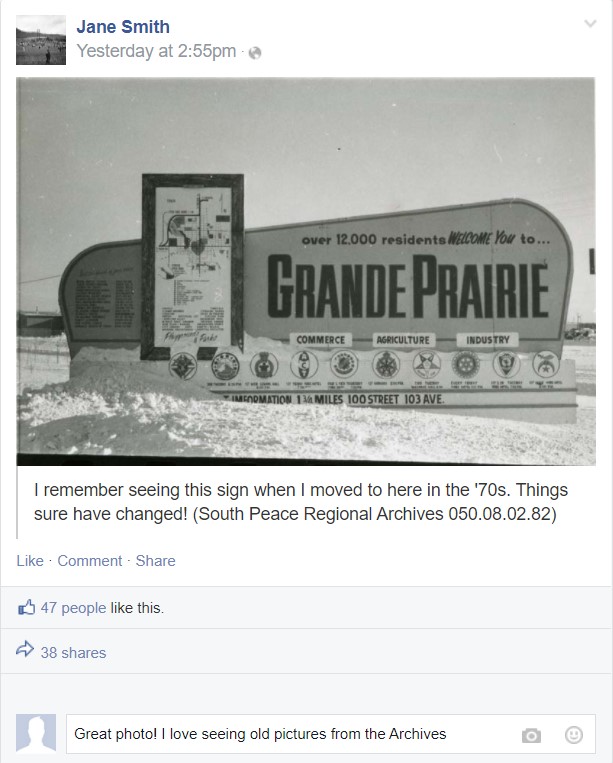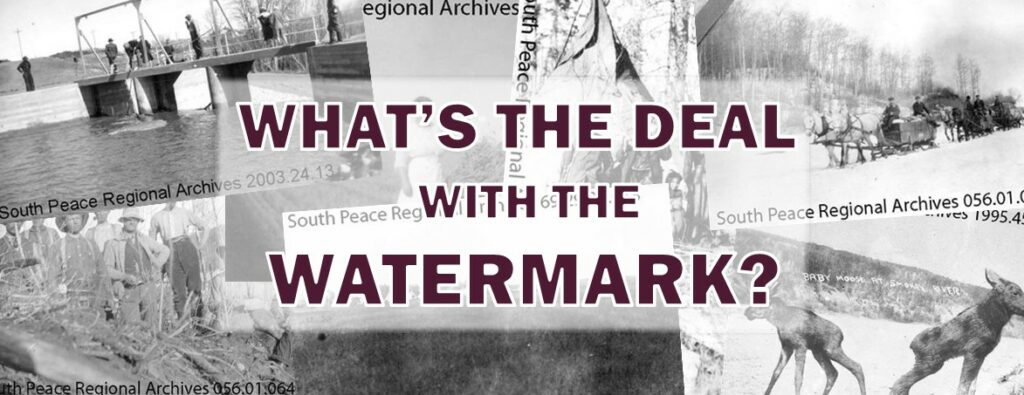We’ve received several questions recently about the presence of watermarks on photographs from the Archives collections. We thought this would be a great opportunity to educate our readers about why we watermark these photos and why it is important to credit the Archives as the source of these images!
Why do we add watermarks to our photographs?
The Archives adds watermarks to photographs in our collections so that people know the source of image when it is shared online. We know it can distract from the beauty of the image, which is why you won’t see a watermark on all photographs, but we have many important reasons why we do it!
Who gets the “credit”?
The photographs that you see online (on the Archives’ website, Facebook page, or Alberta on Record) are the culmination of many people’s efforts: the material donors, who not only donated the records but also graciously agreed that they could be made public; the staff and volunteers at the Archives, who put in countless hours of work to arrange, describe, and digitize the materials; the Archives Society of Alberta, who hosts Alberta on Record as a public service website for its institutional members; the local service organizations like the Grande Prairie Branch of the Alberta Genealogical Society, who provide funding so we can buy necessary special equipment like our professional scanner; and last but certainly not least our municipal funding partners (the City of Grande Prairie, County of Grande Prairie, Municipal District of Greenview, and the Municipal District of Spirit River), who support the Archives through operational funding so that we can serve the residents of our region.
Why should I credit the Archives?
Recognizing the South Peace Regional Archives as the source of the image, “crediting” us, acknowledges the extensive time, effort, and financial contributions that went in to making the image easily accessible on the internet. It helps future researchers locate the source of the image and discover more information about it. This is especially important for folks who wish to order high-quality reproductions of the images; our collections include over a hundred thousand photographs, negatives, and slides, so it is extremely difficult to locate the original without proper sourcing. It is also the law, under the Canadian Copyright Act, as the Archives is the legal owner of the photograph and copyright. Most often, failing to provide credit is an honest mistake, which is why we seek first to educate the public about its importance. Whether you are publishing the image in a academic publication or sharing it with your friends on Facebook, it is important to give credit!
How should I credit the Archives?
It’s easy! When sharing a photograph, mention the South Peace Regional Archives as the source of the image and list the item/location code (see below). If sharing online, you can also add a link to where you found the image. If the image has a watermark, please don’t crop it out.
Why do you make the photographs available at all?
The Archives makes photographs available online because it accomplishes a key aspect of our core mission: gathering, preserving, and sharing historical records of the South Peace region. We are very happy to see the images shared and to see people connecting with our local history! Here at the Archives, we add value to people’s lives by increasing their understanding and appreciation of the past; you can help us do this by sharing the images and other content we make available online, and crediting us as your source.
What’s the big deal?
The South Peace Regional Archives is a non-profit organization, and we are only able to operate because we have the support of the community and our funding partners. If people don’t see or understand the value we add to the community, we risk losing financial assistance and therefore being unable to provide our services. Across the country, community Archives have closed due to budget cuts and lack of public support. We need your help to share the value of having a regional Archives so that we can continue to serve the South Peace.

